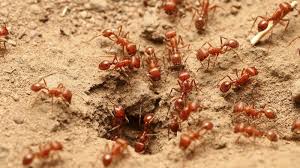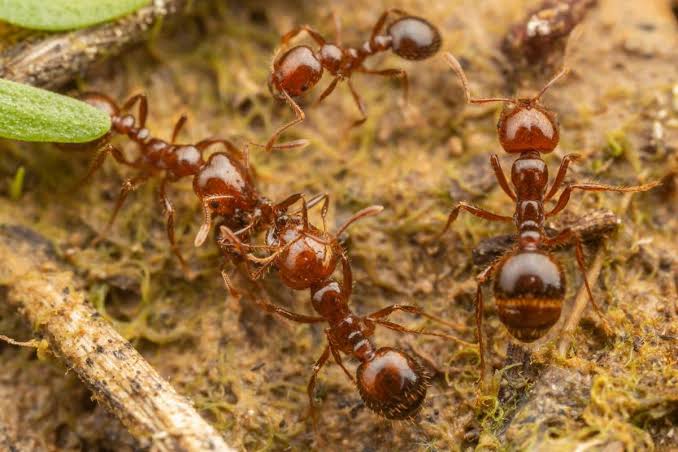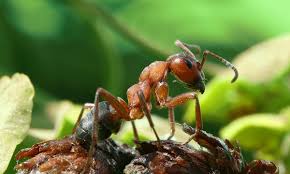Ants scientifically known as Formicidae are amazing insects that live in colonies. They work together in groups, creating intricate societies. One well-known type of ant is the fire ant. Scientifically known as Solenopsis invicta, fire ants are fascinating creatures with unique characteristics.
These ants got their name because of their fiery sting, which can be painful. Fire ants build nests in mounds, often found in soil or rotting wood. Their nests can be quite large and are divided into chambers for different purposes.
Ant colonies consist of various ants, each having specific roles. There are worker ants that gather food, nurse ants that take care of the young, and even soldier ants that protect the colony. The queen ant is essential for laying eggs and ensuring the survival of the colony.
One remarkable aspect of fire ants is their ability to adapt. They can thrive in different environments, from grasslands to urban areas. Fire ants are known for their resilience and resourcefulness in finding food, which can range from insects to sweet substances.
Communication among ants is intriguing. They use pheromones, chemicals released to convey messages. This helps them coordinate activities such as foraging, defending the colony, or even relocating.
Fire ants have a significant impact on ecosystems. They play a role in controlling other insect populations and aid in nutrient cycling by breaking down organic matter. However, their aggressive nature can also pose challenges, especially when they invade areas where they are not native.
Understanding the biology of fire ants involves studying their life cycle. From egg to larva to pupa, the transformation is intricate. The collective behavior of the colony ensures the survival of the species and its ability to thrive in diverse environments.
Interestingly, fire ants are not just known for their stinging ability. They are also skilled architects, building complex nests with a network of tunnels and chambers. This architectural prowess helps them create safe and efficient living spaces for the colony.
In some regions, fire ants are considered pests due to their aggressive nature and painful stings. Controlling their population can be challenging, requiring innovative approaches that balance ecological considerations.
However, ants, especially fire ants, are remarkable insects with intricate social structures, adaptability, and unique features. Studying these tiny creatures provides insights into the complexities of nature and the delicate balance within ecosystems.
Read Also: Wild Dog Description, their Personality and Care Guide
Animals Affected by Ants (Formicidae)

Ants, particularly fire ants (Solenopsis invicta), can have significant effects on various animals and ecosystems. Their presence and behaviors can influence the surrounding wildlife in both direct and indirect ways.
1. Insects: Fire ants are known for their aggressive foraging behavior. They can impact other insect populations by preying on them or competing for resources. This can disrupt the balance of local insect communities.
2. Small Vertebrates: Nesting sites of fire ants may affect small vertebrates like reptiles and ground-nesting birds. The disturbance caused by ant colonies can interfere with the habitat requirements of these animals.
3. Amphibians: Amphibians, such as frogs and toads, may be affected by fire ants. The ants can prey on amphibian eggs or small tadpoles, influencing their reproductive success.
4. Invertebrates: Soil-dwelling invertebrates, like certain beetles and earthworms, can be impacted by fire ants. The ants may compete for food resources or directly prey on these invertebrates, affecting their populations.
5. Small Mammals: Burrowing rodents or small mammals may experience challenges if fire ants invade their habitats. The aggressive nature of the ants can disrupt burrow systems and compete for resources.
6. Plants: Fire ants can indirectly affect plants by disturbing soil conditions. Their nest-building activities and foraging behavior may alter soil structure and nutrient levels, influencing the growth of vegetation in the area.
7. Ecosystem Dynamics: The presence of fire ants can have cascading effects on ecosystem dynamics. Changes in insect, plant, and small animal populations can impact higher trophic levels, creating a ripple effect throughout the ecosystem.
8. Predatory Birds: Birds that feed on insects might be affected by changes in insect abundance caused by fire ants. The altered insect dynamics can influence the food availability for these predatory birds.
9. Aquatic Ecosystems: Fire ants can enter aquatic ecosystems during floods. This intrusion may affect aquatic invertebrates and disrupt the balance of these ecosystems temporarily.
10. Domestic Animals: In some cases, fire ants can pose a threat to domestic animals. Their painful stings can cause discomfort, and if animals disturb ant nests, it may lead to injuries or stress.
Understanding the interactions between fire ants and other species is crucial for managing their impact on ecosystems. Efforts to control invasive ant species should consider the broader ecological implications to maintain a balanced and healthy environment.
Damages Caused by Ants
Ants, including species like fire ants, can cause various damages, posing challenges in both natural and human-altered environments. Here are some common damages associated with ants:
1. Crop Damage: Agricultural crops may suffer as ants, particularly species that cultivate aphids, can protect these plant-damaging insects. This protection allows aphids to feed on crops, leading to reduced yields.
2. Pest Infestations: Ants can create or exacerbate pest problems. For example, in homes, they may be attracted to food sources, causing contamination and making it difficult to control other pests like cockroaches.
3. Property Damage: Certain ant species can damage wooden structures. Carpenter ants, for instance, excavate galleries in wood for nesting, potentially compromising the structural integrity of buildings.
4. Electric and Electronic Equipment: Ants are attracted to electrical currents and warmth. In urban areas, they may invade electronic equipment, such as air conditioning units or electrical boxes, causing malfunctions and damage.
5. Soil Disruption: Ants, especially those building extensive underground nests, can disrupt soil structure. This may affect plant roots, interfere with landscaping efforts, and lead to erosion in certain cases.
6. Invasion of Human Spaces: Ants seeking food can invade homes and businesses, contaminating stored food and causing inconvenience. Some species, like fire ants, are known for their painful stings, posing a threat to human health.
7. Interference with Seed Germination: Certain ant species may interfere with the germination of seeds. They may collect and hoard seeds, preventing them from sprouting or growing into plants.
8. Impact on Beneficial Insects: Ants can have negative effects on beneficial insects. For instance, they may interfere with the activities of predatory insects that naturally control pest populations, upsetting ecological balance.
9. Allergies and Health Risks: Fire ants, in particular, are known for their aggressive behavior and painful stings. Stings can cause allergic reactions in some individuals, and in severe cases, may lead to health complications.
10. Damage to Beehives: Ants may raid beehives, seeking honey and larvae. This intrusion can stress honeybee colonies and affect their overall productivity.
Effective pest management strategies are crucial to mitigate the damages caused by ants. Understanding the specific behaviors and habits of different ant species allows for targeted approaches to control and minimize their impact on both natural ecosystems and human environments.
Read Also: 15 Amazing Dog Facts you Don’t Know About
Control and Preventive Measures

Controlling and preventing ant infestations, especially for species like fire ants, involves a combination of strategies. Here are some effective measures:
1. Maintain Cleanliness: Keep living and working spaces clean. Regularly clean crumbs, spills, and food debris to eliminate potential food sources that attract ants.
2. Seal Entry Points: Seal gaps, cracks, and openings in windows, doors, and walls. Ants can enter buildings through tiny openings, so sealing these entry points helps prevent their intrusion.
3. Proper Food Storage: Store food in airtight containers. This reduces the accessibility of food for ants, minimizing the chances of them establishing colonies in homes or businesses.
4. Dispose of Trash Properly: Ensure proper waste disposal. Secure trash cans with tight-fitting lids, and dispose of garbage regularly to avoid attracting ants with food remnants.
5. Landscaping Practices: Keep vegetation and trees away from buildings to minimize ant access points. Trim branches that touch or overhang structures to prevent ants from using them as bridges.
6. Eliminate Standing Water: Fix leaks and eliminate standing water around buildings. Ants require water, so removing water sources can deter them from establishing nests in or near structures.
7. Natural Predators: Encourage the presence of natural ant predators like spiders and predatory insects. Maintaining a balanced ecosystem can help control ant populations.
8. Ant Baits: Use ant baits strategically. These baits contain toxins that worker ants bring back to the colony, effectively controlling the entire nest.
9. Diatomaceous Earth: Diatomaceous earth, a non-toxic powder, can be applied around entry points and ant trails. It dehydrates and kills ants upon contact.
10. Professional Pest Control: In severe infestations, consider hiring professional pest control services. They can assess the situation and implement targeted strategies for effective ant control.
11. Natural Repellents: Certain substances like cinnamon, vinegar, or citrus peels are natural ant repellents. Sprinkling these around entry points or ant trails may deter them.
12. Regular Inspections: Conduct regular inspections of your property to identify and address potential ant entry points before infestations become severe.
Combining these measures in an integrated pest management approach is key to effective ant control. Prevention is equally important, and consistent efforts to maintain a clean and unattractive environment can significantly reduce the likelihood of ant infestations.
Frequently Asked Questions (FAQs) About Ants (Formicidae)
1. Q: What are ants?
A: Ants are social insects belonging to the family Formicidae. They live in colonies and are known for their organized societies with specific roles for different ant types.
2. Q: What is the scientific name for fire ants?
A: Fire ants belong to the species Solenopsis invicta.
3. Q: Why are they called fire ants?
A: Fire ants are named for their painful sting, which can feel like a burning sensation. Their sting can cause discomfort and, in some cases, allergic reactions.
4. Q: How do ants communicate?
A: Ants communicate primarily through pheromones, chemical signals that convey messages. These pheromones help coordinate activities such as foraging, defending the colony, and marking paths.
5. Q: What is the role of the queen ant?
A: The queen ant is crucial for the colony’s reproduction. She lays eggs, ensuring the survival and growth of the ant population.
6. Q: How do ants build their nests?
A: Ants are skilled architects, building nests with a network of tunnels and chambers. Nest construction varies among species, with some building mounds on the ground and others creating nests in wood or soil.
7. Q: Do ants pose any health risks?
A: Some ants, like fire ants, can pose health risks due to their painful stings. In certain cases, individuals may be allergic to ant stings, leading to severe reactions.
8. Q: Can ants damage property?
A: Yes, certain ant species, such as carpenter ants, can damage wooden structures by excavating galleries for nesting. Additionally, invasive ant species may cause problems in electronic equipment.
9. Q: How can I prevent ant infestations at home?
A: Maintaining cleanliness, sealing entry points, proper food storage, and eliminating standing water are effective preventive measures. Using ant baits and natural repellents can also help.
10. Q: Are there natural predators of ants?
A: Yes, ants have natural predators, including spiders, other insects, and certain birds. Maintaining a balanced ecosystem can help control ant populations naturally.
11. Q: What should I do if I have a severe ant infestation?
A: Consider hiring professional pest control services. They can assess the situation and implement targeted strategies for effective ant control based on the specific species and infestation severity.
Read Also: How to Grow Microgreens

